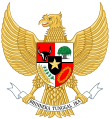
Back الانتخابات الرئاسية الإندونيسية 2014 Arabic Präsidentschaftswahl in Indonesien 2014 German Ινδονησιακές προεδρικές εκλογές (2014) Greek Elecciones presidenciales de Indonesia de 2014 Spanish Indonesian presidentinvaali 2014 Finnish Élection présidentielle indonésienne de 2014 French Pemilihan umum Presiden Indonesia 2014 ID Elezioni presidenziali in Indonesia del 2014 Italian 2014年インドネシア大統領選挙 Japanese 2014년 인도네시아 대통령 선거 Korean
| ||||||||||||||||||||||
| Registered | 193,944,150 ( | |||||||||||||||||||||
|---|---|---|---|---|---|---|---|---|---|---|---|---|---|---|---|---|---|---|---|---|---|---|
| Turnout | 69.58% ( | |||||||||||||||||||||
| ||||||||||||||||||||||
| ||||||||||||||||||||||
| This article is part of a series on the |
| Politics of Indonesia |
|---|
 |
Presidential elections were held in Indonesia on 9 July 2014,[1] with former general Prabowo Subianto contesting the elections against the governor of Jakarta, Joko Widodo; incumbent president Susilo Bambang Yudhoyono was constitutionally barred from seeking a third term in office.[2][3] On 22 July the General Elections Commission (KPU) announced Joko Widodo's victory. He and his vice president, Jusuf Kalla, were sworn-in on 20 October 2014, for a five-year term.[4]
According to the 2008 election law, only parties or coalitions controlling 20% of DPR seats or winning 25% of the popular votes in the 2014 parliamentary elections are eligible to nominate a candidate. This law was challenged in the Constitutional Court,[5] but in late January 2014, the court ruled that the requirement would stand for this election.[6] No party exceeded the threshold in the 2014 legislative elections; therefore, two coalitions were formed.
Cite error: There are <ref group=lower-alpha> tags or {{efn}} templates on this page, but the references will not show without a {{reflist|group=lower-alpha}} template or {{notelist}} template (see the help page).
- ^ Hill, Cameron (28 March 2014). "Indonesia's 2014 national elections: a quick guide". Parliament of Australia. Retrieved 6 April 2014.
- ^ Denny Indrayana (2008) Indonesian Constitutional Reform 1999–2002: An Evaluation of Constitution-Making in Transition, Kompas Book Publishing, Jakarta ISBN 978-979-709-394-5.
- ^ Law No. 42/2008 on the Election of the President and Vice-president Archived 9 October 2009 at the Wayback Machine (in Indonesian)
- ^ Prokurat, Sergiusz (2014), Indonesian parliamentary and presidential elections in 2014. The electoral process and economic challenges (PDF), Józefów: Socio-economic relations between Europe and Asia in the 21st century", pp. 197–210, ISBN 978-83-62753-53-6, archived from the original (PDF) on 22 September 2016, retrieved 28 July 2016
- ^ Markus Junianto Sihaloho, 'Presidential Threshold Likely to Here to Stay' Archived 16 September 2013 at the Wayback Machine, Jakarta Globe, 13 September 2013.
- ^ Parlina, Ina (25 January 2014). "Ruling stymies Prabowo's bid". The Jakarta Post. Retrieved 27 March 2023.




